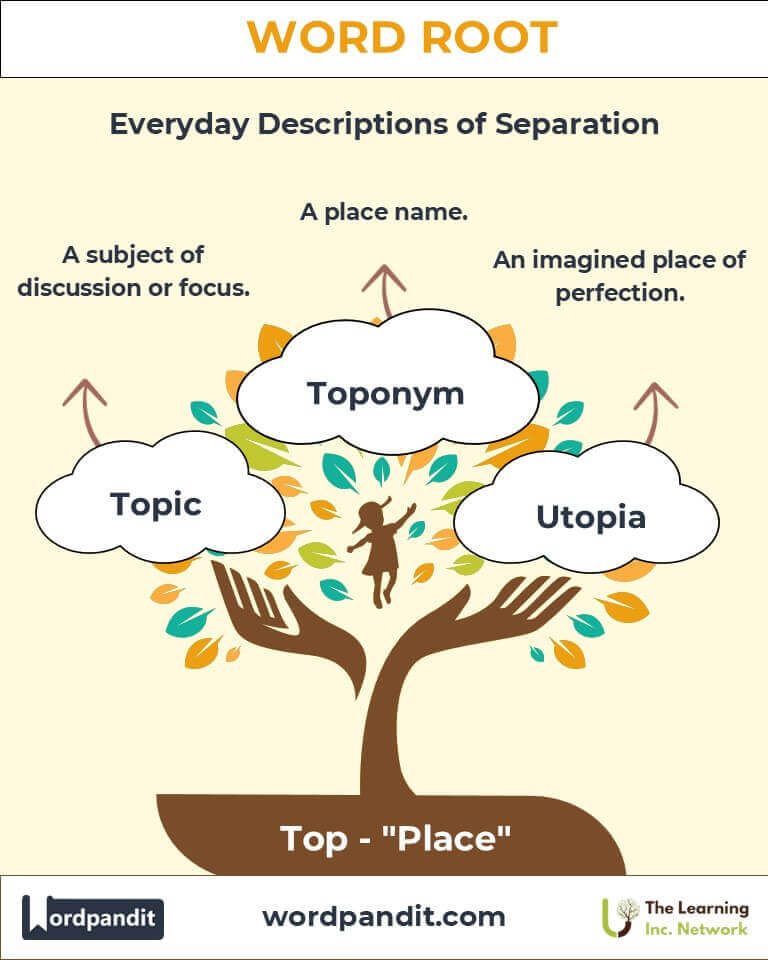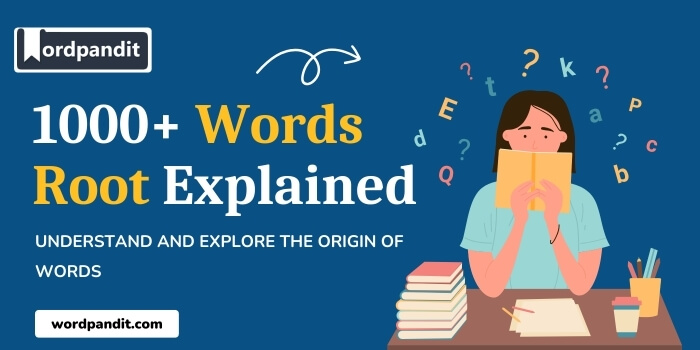Top: Exploring the Root of Place and Space in Language and Thought
Byline: Discover the significance of the root "Top," originating from Greek and meaning "place." From terms like "topic" to specialized words like "topology," this root illuminates the concept of location, structure, and arrangement in diverse fields, from conversation to mathematics.

Table of Contents
- Introduction: The Essence of "Top"
- Etymology and Historical Journey
- Mnemonic: Unlocking the Power of "Top"
- Common "Top"-Related Terms
- "Top" Through Time
- "Top" in Specialized Fields
- Illustrative Story: "Top" in Action
- Cultural Significance of the "Top" Root
- The "Top" Family Tree
- FAQs About the "Top" Word Root
- Test Your Knowledge: "Top" Word Root Quiz
- Conclusion: The Living Legacy of "Top"
1. Introduction: The Essence of "Top"
Imagine a map guiding you to a destination or a debate narrowing in on its core subject. These scenarios highlight the root Top, derived from the Greek topos (place). Whether discussing geography, structure, or abstract thought, Top offers clarity and focus, making it indispensable in language and knowledge.

2. Etymology and Historical Journey
The word root Top traces back to Greek topos, signifying "place" or "region." The term entered English through Latin during the Renaissance, bringing with it the rich concept of spatial arrangement and contextual relevance. Its adoption in diverse disciplines such as geometry, philosophy, and linguistics underscores its enduring utility.
3. Mnemonic: Unlocking the Power of "Top"
To remember Top, visualize a spinning top stabilizing on a surface, symbolizing focus and precision.
Mnemonic Device: "‘Top’ is where places meet—focus on the map of ideas!"
4. Common "Top"-Related Terms
- Topic (top-ik):
- Definition: A subject of discussion or focus.
- Example: "The meeting's main topic was sustainability."
- Topology (top-ol-oh-jee):
- Definition: The study of spatial properties preserved under transformations.
- Example: "Topology helps us understand networks like the internet."
- Toponym (top-uh-nim):
- Definition: A place name.
- Example: "New York is a toponym with historical significance."
- Topographic (top-oh-graf-ik):
- Definition: Relating to the detailed mapping of an area.
- Example: "Topographic maps are essential for hikers."
- Utopia (yoo-toh-pee-uh):
- Definition: An imagined place of perfection.
- Example: "The novel described a utopia free from conflict."
5. "Top" Through Time
- Aristotle's "Topica": An ancient text discussing argumentation and logical structure, linking "topos" to reasoning.
Impact: Established the idea of "place" as a conceptual foundation in philosophy. - Modern Topology: Once confined to geometry, it now applies to computer science, biology, and more, showing the root’s versatility.
6. "Top" in Specialized Fields
- Mathematics:
- Topology: Studies properties like connectedness and continuity.
Relevance: Vital in theoretical physics and advanced geometry.
- Topology: Studies properties like connectedness and continuity.
- Geography:
- Topography: Maps physical features of landscapes.
Application: Used in urban planning and environmental studies.
- Topography: Maps physical features of landscapes.
- Linguistics:
- Topic: Refers to the focus of a sentence.
Example: Enhances clarity and comprehension in communication.
- Topic: Refers to the focus of a sentence.
7. Illustrative Story: "Top" in Action
Emma, a cartographer, was tasked with creating a topographic map of a national park. Her tools, a blend of traditional methods and topology software, revealed both the park’s physical beauty and the intricate connections of its ecosystems. Meanwhile, her colleague, a linguist, presented on the toponyms of the area, uncovering cultural stories tied to each name. Together, they showcased how "Top" brings order and meaning to both space and knowledge.
8. Cultural Significance of the "Top" Root
"Top" reflects humanity's need to categorize and navigate space, both physical and abstract. Ancient Greek philosophers used topos for logical and rhetorical frameworks, while modern disciplines rely on it to interpret everything from data structures to environmental systems.

9. The "Top" Family Tree
- Geo- (Earth):
- Geotop: A geographical place or feature.
- Graph- (Writing):
- Topograph: A detailed written depiction of a place.
- Nom- (Name):
- Toponym: A name derived from a place.
Example: "Toponyms like 'Mount Everest' reveal historical and geographical significance."
- Toponym: A name derived from a place.

10. FAQs About " Top "
Q: What does "Top" mean?
A: "Top" means "place" and comes from the Greek topos. It represents physical locations, abstract spaces, or figurative topics of discussion, making it a versatile root across disciplines.
Q: What is the difference between "Topic" and "Topography"?
A: A topic is an abstract focus of conversation, study, or writing, while topography refers to the detailed mapping and description of Earth's surface features, such as mountains, valleys, and rivers.
Q: How is "Topology" different from "Topography"?
A: Topology studies spatial properties that remain unchanged under transformations, like stretching or bending, making it a field in mathematics and physics. In contrast, topography is about mapping and visually representing physical landforms.
Q: What are toponyms, and why are they significant?
A: Toponyms are place names, like "New York" or "Mount Everest." They hold cultural, historical, and geographical significance, revealing stories about a location's past or its natural features.
Q: Is "Utopia" a real place?
A: No, "Utopia" was coined by Sir Thomas More in his 1516 book. It combines Greek ou (not) and topos (place), meaning "no place," and refers to an ideal but imaginary society.
11. Test Your Knowledge: " Top " Mastery Quiz
1. What does "Top" signify?
2. Which field studies spatial properties?
3. What is a "Toponym"?
4. Who authored "Topica"?
5. What does "Utopia" mean?
12. Conclusion: The Living Legacy of "Top"
The root Top continues to ground our understanding of space, structure, and meaning. From mapping landscapes to framing arguments, it remains a cornerstone of clarity and exploration. As we delve deeper into its applications, Top inspires us to connect and navigate the ever-evolving terrains of thought and discovery.












